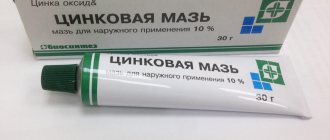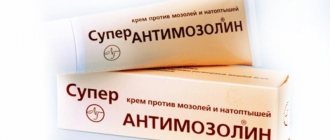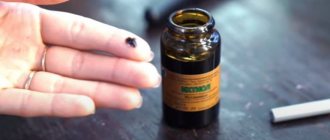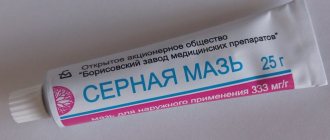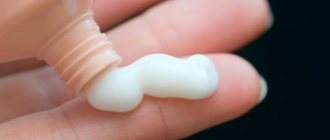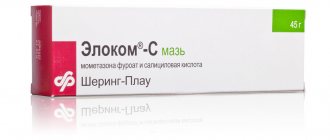Heparin ointment is a direct anticoagulant. It is intended for external use. The drug is a white or slightly yellowish homogeneous mass. Heparin ointment is made on the basis of petroleum jelly, which ensures ease of application. The stability of the composition is maintained by glycerin.
The combined drug contains three main components:
- Heparin sodium. This substance is an anticoagulant. It promotes the resorption of hematomas, relieves swelling and reduces inflammatory processes.
- Benzocaine, which provides the drug with analgesic properties.
- Benzyl nicotinate. This substance accelerates the penetration of heparin through the skin.
The long shelf life of the drug and the preservation of medicinal properties are ensured by the presence of a preservative in the composition - nipagin. The anti-inflammatory effect of the ointment is enhanced by another additional component - peach oil.
The ointment is packaged in compact aluminum tubes of 10, 20, 25, 30 or 50 g. This allows you to select the amount of product according to the situation. The tube is packaged in a cardboard box along with instructions for use of the medicinal product.
Pharmacodynamics and pharmacokinetics
Pharmacodynamics
When applied to the skin, the ointment prevents the formation of blood clots and has an anti-inflammatory and local anesthetic effect.
Heparin , which is gradually released from the ointment, reduces the inflammatory process and has an antithrombotic effect ; benzyl nicotinate (benzyl ester of nicotinic acid) dilates superficial vessels, thereby promoting the absorption of heparin ; Benzocaine relieves pain.
Pharmacokinetics
Heparin from the skin surface in small quantities. Up to 95% of the substance is in a state bound to plasma proteins, the volume of distribution (Vd) is 0.06 l/kg.
It does not penetrate the placental barrier or into breast milk.
Metabolized in the liver. T1/2 of heparin - on average, 1.5 hours. The substance is excreted by the kidneys.
Local application of Heparin ointment does not lead to changes in blood .
Benzyl nicotinate penetrates all layers of the skin, but practically does not enter the systemic circulation. Benzocaine is almost not absorbed when applied externally.
Side effects
With prolonged use, local reactions may develop in the form of decreased sensitivity in the treated area, skin hyperemia, hypersensitivity reactions ( skin rash , itching ).
When using topical forms of heparin , the risk of developing type II HIT (with a sharp drop in platelet (Tr) to <50% of the initial value, a decrease in the number of Thr <100,000 × 109/l, with venous/arterial thrombosis or embolism) cannot be excluded.
For this reason, when using the drug, the level of Tr in the blood should be additionally monitored in patients with a history of thromboembolism
In patients without pre-existing hypersensitivity to heparin, with parenteral administration of heparin , a decrease in Tp levels is usually observed 6-14 days after the start of treatment. In case of hypersensitivity to heparin, HIT may develop within a few hours.
Side effects
Topical
(local application) forms of heparin do not change systemic blood parameters. However, long-term use of the drug may cause skin reactions:
- redness on the skin;
- itching;
- rash.
Even with a slight manifestation of an allergy, treatment with the drug should be stopped immediately.
Heparin ointment, instructions for use (Method and dosage)
Instructions for use of Heparin ointment for phlebitis and thrombophlebitis
For post-infusion/post-injection phlebitis , as well as for the treatment of thrombophlebitis of the superficial veins, the ointment 2-3 times a day is applied in a thin layer to the affected area and gently rubbed into the skin. To treat an area with a diameter of 3-5 cm, 0.5-1 g of the drug is enough. Treatment usually lasts from 3 to 7 days.
Heparin ointment for hemorrhoids
In case of exacerbation of chronic hemorrhoids, the ointment is applied directly to the inflamed hemorrhoids on a linen or calico pad, which is then fixed with a bandage.
Reviews indicate that another way of using the drug is no less effective - in the form of tampons: the tampon is soaked in ointment and then inserted into the anus.
to use Heparin ointment for hemorrhoids daily 2 or 3 times a day until the inflammation disappears. Treatment lasts no more than 10 days.
Hemorrhoids are a fairly common occurrence during pregnancy , but it should be remembered that pregnant women are allowed to use any medications only with the approval of a doctor.
Heparin ointment for varicose veins
For varicose veins , the drug is especially effective in the early stages of the disease, when spider veins and dilated veins are just beginning to appear: the product reduces pain, relieves the feeling of heaviness, redness, itching and swelling, accelerates the resorption of already formed blood clots and prevents the formation of new ones, and normalizes microcirculation.
The medicine should be applied to the area of altered blood vessels daily 3 times a day for 2 weeks.
Contraindications for use in varicose veins ( varicose veins ) are the presence of open ulcers or any other damage to the skin, as well as known intolerance to any drug from the group of local anesthetics.
Heparin ointment for bruises
Heparin is considered one of the most effective remedies for bruises. Having an anticoagulant effect , it accelerates the resorption of blood clots formed under the skin and improves the condition of capillaries.
The benzyl ester of nicotinic acid contained in Heparin ointment has a vasodilating effect, thereby improving the absorption of heparin . The local anesthetic benzocaine helps relieve pain.
Method of using ointment for bruises: the course of treatment heparin -containing agents ranges from 5 to 15 days. The ointment is applied to the site of the injury/bruise 2-3 times a day and gently rubbed into the skin.
Almost all the reviews that can be read on forums about Heparin ointment are positive: the product copes with subcutaneous hematomas in 2-4 days.
Why is Heparin ointment used in cosmetology?
Many pharmaceutical products are quite successfully used to eliminate certain cosmetic defects. Since the main indications for the use of Heparin ointment are VVR, hemorrhoids , mastitis , bruises, the question naturally arises, why can the drug be used in cosmetology?
For the face, ointment is used as a remedy:
- from wrinkles;
- for acne;
- from bags under the eyes.
One of the signs that a person has impaired blood flow is swelling . And they are especially noticeable under the eyes, since the skin in this place is very thin and delicate. Swelling is often accompanied by darkening of the skin.
To get rid of this problem, you should apply Heparin ointment under the eyes once a day: with your fingertips, lightly patting the skin, and not too close to the mucous membrane.
Important! For the face, the drug is used only after testing for allergies to it. To check the tolerability of the product, apply it to the inside of the wrist or elbow and observe the reaction.
The ointment relieves inflammation well and reduces pain in the affected area. Due to these properties, it is sometimes used as a remedy for acne. For this purpose, the drug is applied to the face in a thin layer 3 times a day until the inflammation completely goes away.
In the same way, the drug is used to treat rosacea .
As a remedy for wrinkles, Heparin ointment is used 2 times a day. Apply it with light massage movements without stretching the skin (especially around the eyes). The anti-aging properties of heparin are most likely due to its absorbent and anti-edematous properties.
Reviews about the use of the facial product allow us to conclude that it is impossible to radically solve the problem of wrinkles that have already appeared with the help of the drug. However, it is able to prevent the emergence of new ones and stop the development of existing ones.
Composition and action
Heparin ointment
is a complex product for external use. Available in tubes of 10, 25 or 50 g. Produced by several domestic and Belarusian pharmaceutical factories. It contains three active ingredients:
| Component | Quantity | Action |
| Heparin sodium | 100 IU/g | anticoagulant |
| Benzocaine | 40 mg/g | local anesthetic |
| Benzyl nicotinate | 0.8 mg/g | local vasodilator |
As the name suggests, the main “actor” of the drug is heparin. This substance is an anticoagulant, it increases blood fluidity and dissolves blood clots. In cardiological practice, heparin is used for myocardial infarction and embolism.
As part of the ointment, it acts in a similar way on superficial hematomas, helps with varicose veins and thrombophlebitis, reduces hemorrhoids and reduces their swelling.
Benzocaine acts as an anesthetic for bruises, varicose veins and hemorrhoids. Benzyl nicotinate performs a transport function - it promotes maximum absorption of active substances, providing a local vasodilator effect. The composition contains glycerin, petroleum jelly and peach oil as a fatty base.
Interaction
The anticoagulant effect of heparin is enhanced by the simultaneous use of the drug with antiplatelet agents , anticoagulants and NSAIDs.
The use of the drug with thyrotoxin , ergot alkaloids , antihistamines , tetracycline and nicotine reduce the effect of heparin .
Heparin should not be administered topically in combination with NSAIDs, H1-histamine receptor blockers, or tetracyclines.
Drug compatibility
The action of some drugs reduces the effectiveness of Heparin ointment. These include:
- Tetracycline (in the form of ointments and tablets);
- L-thyroxine (hormone replacement drug for the treatment of hypothyroidism);
- allergy medications (antihistamines);
- anti-inflammatory gels and ointments (for example, Voltaren).
It is not advisable to use the product simultaneously with other external medications containing antibiotics.
Nicotine reduces the effectiveness of heparin, so it is better to quit smoking during treatment.
Antiplatelet drugs and non-steroidal anti-inflammatory drugs enhance the effects of heparin.
special instructions
If long-term treatment is necessary, as well as in the case of using the drug to treat large areas of the body and simultaneous ingestion of drugs that affect hematopoiesis and/or coagulation system, it is necessary to monitor PTI and clotting time.
Similar monitoring is required if long-term use is necessary and for large areas of damage in women over 65 years of age and in pregnant women.
The drug is not intended for treating open wounds. Also, you should not apply it to the skin in the presence of purulent processes.
Not recommended for use in cases of DVT ( deep vein thrombosis ).
Due to the possibility of systemic action of heparin, patients with a history of thromboembolic complications
Methyl and propyl parahydroxybenzoate may cause delayed hypersensitivity reactions.
Does not adversely affect the ability to operate machinery and drive vehicles.
Analogs
Level 4 ATC code matches:
Girudoproct
Heparoid Zentiva
Heparin
Gepatrombin G
Lyoton
Trombless
Venolife
Hepatrombin
Analogs of Heparin ointment with a similar mechanism of action: Venolife , Venitan Forte , Hepatrombin , Geparoid Zentiva , Trombless , Contractubex , Lyoton 1000 , Venabos , Heparin , Venabos , Trombless Plus .
Which is better: Lyoton or Heparin ointment?
The drug Lyoton 1000 , like its analogue, contains sodium heparin as an active substance, but in a much higher concentration - 1000 IU/g.
Lyoton is produced in the form of a gel, therefore, it penetrates the skin better and faster than products produced in the form of an ointment.
Another difference between the drugs is that Heparin ointment, in addition to heparin, also contains components that enhance its effect - benzyl nicotinate and benzocaine .
Which is better: Troxevasin or Heparin ointment?
Troxevasin is a capillary stabilizing agent. Its active substance is a mixture of bioflavonoids , which contains at least 95% troxerutin ( troxerutin in 1 gram of ointment is 20 mg).
The action of the drug is aimed at reducing swelling, pain, improving trophism and eliminating various kinds of pathological disorders caused by venous insufficiency.
Both drugs are good, but their effects are somewhat different. Troxerutin has venotonic, angioprotective, anti-edematous and anti-inflammatory effects. Heparin is a local anesthetic and anticoagulant.
It is believed that Troxevasin is more effective when it is necessary to relieve swelling, and its analogue is more effective when it is necessary to accelerate the resorption of the hematoma.
Price and analogues
The cost of Heparin ointment ranges from 24 to 86 rubles, depending on the manufacturer and the capacity of the tube. Heparin is included in some treatments for varicose veins. They have similar indications for use:
| Analogue | Active substance | Price |
| Gel Lyoton 1000 | Heparin sodium | 270-1000 rubles depending on volume (30, 50, 100 g) |
| Gel Troxevasin Neo |
| From 200 to 270 rubles |
| Wessel due F | Sulodexide | 2700 |
The drug is stored for 3 years at a temperature not exceeding 20°C. You can buy it at a pharmacy without a prescription.
Reviews of Heparin ointment
Heparin ointment is an inexpensive and very effective remedy. It is used for hemorrhoids , bruises , and varicose veins . You can also find good reviews about Heparin ointment for the face: in cosmetology, the drug is most often used to eliminate bruises and bags under the eyes.
Reviews about Heparin Ointment for Wrinkles are more controversial: some say that the drug is very effective in the fight to preserve youthful skin, while others claim that they have not noticed any serious improvements.
But reviews of Heparin ointment for hemorrhoids are extremely positive - the drug works great when it comes to such a delicate problem, and if indicated, it can be used even during pregnancy.
varicose veins has proven itself no less well : patients say that spider veins on the legs noticeably decrease (and sometimes completely disappear) after just 1-2 weeks of regular use.
Indications for use
Heparin ointment is used to treat:
- bruises;
- lumps formed as a result of intramuscular injections or bruises after intravenous infusions when the integrity of the vein is violated;
- phlebitis and thrombophlebitis;
- varicose veins;
- external hemorrhoids;
- secondary inflammation of the lymph nodes.
In addition, it is successfully used by women to eliminate facial skin imperfections, and by men to increase potency.
How much does Heparin ointment cost?
The price of Heparin ointment in Russia is from 63 to 92 rubles: you can buy a manufactured drug for 64 rubles, and the cost of an ointment for external use produced by is 85 rubles.
The price of Heparin ointment in Ukraine is from 46 to 60 UAH. At the same time, the price in Kharkov is practically no different from the price in Kyiv or, for example, Odessa pharmacies.
- Online pharmacies in RussiaRussia
- Online pharmacies in UkraineUkraine
ZdravCity
- Heparin ointment 25g Belmedpreparaty RUP Belmedpreparaty
73 RUR order - Heparin ointment 25g NizhpharmAO "Nizhpharm"
82 RUR order
- Heparin ointment 25g Green DubravaGreen Dubrava JSC
59 RUR order
Pharmacy Dialogue
- Heparin ointment (tube 25g) Nizhpharm JSC
72 RUR order
- Heparin ointment (tube 25g)Green oak forest
52 RUR order
show more
Pharmacy24
- Heparin ointment 25 g TOV DKP Pharm.Fabrika, Ukraine
46 UAH order
